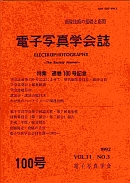Volume 36, Issue 4
Displaying 1-12 of 12 articles from this issue
- |<
- <
- 1
- >
- >|
Original Articles
-
1997Volume 36Issue 4 Pages 260-267
Published: 1997
Released on J-STAGE: April 06, 2007
Download PDF (1181K) -
1997Volume 36Issue 4 Pages 268-274
Published: 1997
Released on J-STAGE: April 06, 2007
Download PDF (1025K) -
1997Volume 36Issue 4 Pages 275-279
Published: 1997
Released on J-STAGE: April 06, 2007
Download PDF (527K)
Technical Review
-
1997Volume 36Issue 4 Pages 280-288
Published: 1997
Released on J-STAGE: April 06, 2007
Download PDF (2102K)
Imaging Today
“Frontier in Digital Electrophotography”
“Frontier in Digital Electrophotography”
-
1997Volume 36Issue 4 Pages 290-296
Published: 1997
Released on J-STAGE: April 06, 2007
Download PDF (1379K) -
1997Volume 36Issue 4 Pages 297-302
Published: 1997
Released on J-STAGE: April 06, 2007
Download PDF (3237K) -
1997Volume 36Issue 4 Pages 303-309
Published: 1997
Released on J-STAGE: April 06, 2007
Download PDF (1571K) -
1997Volume 36Issue 4 Pages 310-315
Published: 1997
Released on J-STAGE: April 06, 2007
Download PDF (1032K) -
1997Volume 36Issue 4 Pages 316-323
Published: 1997
Released on J-STAGE: April 06, 2007
Download PDF (1544K) -
1997Volume 36Issue 4 Pages 324-335
Published: 1997
Released on J-STAGE: April 06, 2007
Download PDF (3320K) -
1997Volume 36Issue 4 Pages 336-342
Published: 1997
Released on J-STAGE: April 06, 2007
Download PDF (1368K) -
1997Volume 36Issue 4 Pages 343-352
Published: 1997
Released on J-STAGE: April 06, 2007
Download PDF (1719K)
- |<
- <
- 1
- >
- >|
